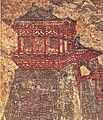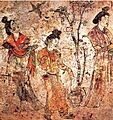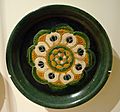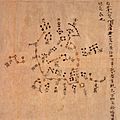Tang Dynasty facts for kids
Quick facts for kids
Tang
唐
|
|||||||||||||||||||||||||
|---|---|---|---|---|---|---|---|---|---|---|---|---|---|---|---|---|---|---|---|---|---|---|---|---|---|
|
|||||||||||||||||||||||||
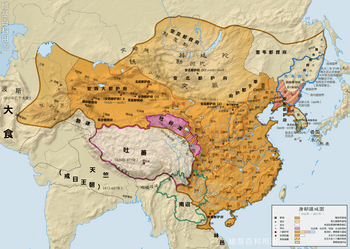
Tang dynasty c. 669
|
|||||||||||||||||||||||||
| Capital | |||||||||||||||||||||||||
| Common languages | Middle Chinese | ||||||||||||||||||||||||
| Religion |
|
||||||||||||||||||||||||
| Government | Monarchy | ||||||||||||||||||||||||
| Emperor | |||||||||||||||||||||||||
|
• 618–626 (first)
|
Emperor Gaozu | ||||||||||||||||||||||||
|
• 626–649
|
Emperor Taizong | ||||||||||||||||||||||||
|
• 712–756
|
Emperor Xuanzong | ||||||||||||||||||||||||
| History | |||||||||||||||||||||||||
|
• Established
|
June 18, 618 | ||||||||||||||||||||||||
|
• Usurped
by Wu Zetian |
690–705a | ||||||||||||||||||||||||
|
• An Lushan Rebellion
|
755–763b | ||||||||||||||||||||||||
|
• Abdication in favour of the Later Liang
|
June 1, 907 | ||||||||||||||||||||||||
| Area | |||||||||||||||||||||||||
| 715 | 5,400,000 km2 (2,100,000 sq mi) | ||||||||||||||||||||||||
| Population | |||||||||||||||||||||||||
|
• 7th century
|
50 million | ||||||||||||||||||||||||
|
• 9th century
|
80 million | ||||||||||||||||||||||||
| Currency |
|
||||||||||||||||||||||||
|
|||||||||||||||||||||||||
|
a October 8, 690 – March 3, 705.
b December 16, 755 – February 17, 763. |
|||||||||||||||||||||||||
| Tang Dynasty | |||||||||||||||||||||||||||||
|---|---|---|---|---|---|---|---|---|---|---|---|---|---|---|---|---|---|---|---|---|---|---|---|---|---|---|---|---|---|

"Tang dynasty" in Han characters
|
|||||||||||||||||||||||||||||
| Chinese | 唐朝 | ||||||||||||||||||||||||||||
|
|||||||||||||||||||||||||||||
The Tang Dynasty (Chinese: 唐朝; Pinyin: Táng Cháo) (18 June 618 – 4 June 907) was an imperial dynasty of China that came after the Sui Dynasty and was followed by the Five Dynasties and Ten Kingdoms Period. It was founded by the Li (李) family, who came to power during the fall of the Sui Empire. The dynasty was interrupted for a short time by the Zhou Dynasty (周) (16 October 690 – 3 March 705) founded by Empress Wu Zetian who managed to claim the throne, becoming the first and only Chinese Empress.
The Tang Dynasty, with its capital at Chang'an (today Xi'an), the biggest city in the world at the time, is considered by historians as a high point in Chinese civilization—maybe even greater than the earlier Han Dynasty—as well as a golden age of cosmopolitan culture.
Empress Wu, the first woman to ever rule in China, was also included in the Tang Dynasty. Her methods were sometimes vicious, but she was very intelligent and talented.
In 907 the Tang dynasty was ended when Zhu Wen deposed Emperor Ai of Tang and took the throne for himself (known posthumously as Emperor Taizu of Later Liang). He established the Later Liang, which inaugurated the Five Dynasties and Ten Kingdoms period. A year later Zhu had the deposed Emperor Ai poisoned to death.
Images for kids
-
Portrait painting of Emperor Yang of Sui, commissioned in 643 by Taizong, painted by Yan Liben (600–673)
-
The Fengxian cave (circa 675 AD) of the Longmen Grottoes, commissioned by Wu Zetian.
-
Xumi Pagoda, built in 636
-
A late Tang mural commemorating the victory of General Zhang Yichao over the Tibetans in 848 AD, from Mogao cave 156
-
Emperor Xuanzong of Tang wearing the robes and hat of a scholar
-
Civil service exam candidates gather around the wall where results had been posted. Artwork by Qiu Ying.
-
Emperor Taizong (r. 626–649) receives Gar Tongtsen Yülsung, ambassador of the Tibetan Empire, at his court; later copy of an original painted in 641 by Yan Liben (600–673)
-
Pottery tomb figure of a warrior from Duan's Tomb, Shaanxi.
-
A 10th-century mural painting in the Mogao Caves at Dunhuang showing monastic architecture from Mount Wutai, Tang dynasty; Japanese architecture of this period was influenced by Tang Chinese architecture
-
Illustration of Byzantine embassy to Tang Taizong 643 CE
-
Sancai glazed horse tomb figure
-
A mural depicting a corner tower, most likely one of Chang'an, from the tomb of Prince Yide (d. 701) at the Qianling Mausoleum, dated 706
-
A Tang dynasty era copy of the preface to the Lantingji Xu poems composed at the Orchid Pavilion Gathering, originally attributed to Wang Xizhi (303–361 AD) of the Jin dynasty
-
Calligraphy of Emperor Taizong on a Tang stele
-
A Tang dynasty sculpture of a Bodhisattva
-
A Tang sancai-glazed carved relief showing horseback riders playing polo
-
Palace ladies in a garden from a mural of Prince Li Xian's tomb in the Qianling Mausoleum, where Wu Zetian was also buried in 706
-
A page of Lu Yu's The Classic of Tea
-
The Diamond Sutra, printed in 868, is the world's first widely printed book to include a specific date of printing.
-
The Dunhuang map, a star map showing the North Polar region. c. 700. The whole set of star maps contains over 1,300 stars.
-
Emperor Xuanzong of Tang giving audience to Zhang Guo, by Ren Renfa (1254–1327)
See also
 In Spanish: Dinastía Tang para niños
In Spanish: Dinastía Tang para niños



















